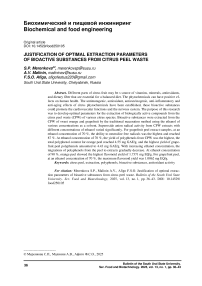Justification of optimal extraction parameters of bioactive substances from citrus peel waste
Автор: Merenkova S.P., Malinin A.V., Afigo F.S.O.
Рубрика: Биохимический и пищевой инжиниринг
Статья в выпуске: 1 т.13, 2025 года.
Бесплатный доступ
Different parts of citrus fruit may be s source of vitamins, minerals, antioxidants, and dietary fiber that are essential for a balanced diet. The phytochemicals can have positive effects on human health. The antimutagenic, antioxidant, anticarcinogenic, anti-inflammatory and anti-aging effects of citrus phytochemicals have been established, these bioactive substances could promote the cardiovascular functions and the nervous system. The purpose of this research was to develop optimal parameters for the extraction of biologically active compounds from the citrus peel waste (CPW) of various citrus species. Bioactive substances were extracted from the CPW of sweet orange and grapefruit by the traditional maceration method using the ethanol of various concentrations as a solvent. Superoxide anion radical activity from CPW extracts with different concentrations of ethanol varied significantly. For grapefruit peel extract samples, at an ethanol concentration of 70 %, the ability to neutralize free radicals was the highest and reached 87 %. At ethanol concentration of 70 %, the yield of polyphenols from CPW was the highest, the total polyphenol content for orange peel reached 4.55 mg GAE/g, and the highest yield of grapefruit peel polyphenols amounted to 4.43 mg GAE/g. With increasing ethanol concentration, the migrations of polyphenols from the peel to extracts gradually decrease. At ethanol concentration of 90 %, orange peel showed the highest flavonoid yield of 1.7371 mg EQ/g. For grapefruit peel, at an ethanol concentration of 70 %, the maximum flavonoid yield was 1.0062 mg EQ/g.
Citrus peel, extraction, polyphenols, bioactive substances, antioxidant activity
Короткий адрес: https://sciup.org/147247983
IDR: 147247983 | УДК: 663.813:634.31 | DOI: 10.14529/food250105
Текст научной статьи Justification of optimal extraction parameters of bioactive substances from citrus peel waste
Citrus fruits are one of the staple fruits in the daily diet of the population in all countries [1, 2]. From a commercial point of view, citrus fruits are easily processed to produce such popular products as juice, jam, marmalade, canned fruits, and sweets [3]. Oranges, lemons, tangerines, and grapefruits are a rich source of vitamins, minerals, and dietary fiber that are essential every day for a balanced diet. From the citrus peel valuable essential oils are traditionally extracted, which are in demand both in the food industry and in the cosmetic and pharmaceutical sectors [4]. Worldwide, fruits such as lemon, grapefruit, sweet orange, citron, clementine and pomelo are widely used as traditional medicines for the treatment and prevention of various diseases [5].
Numerous studies have evidenced that citrus fruits accumulate secondary metabolites during ripening, as well-known bioactive compounds that can be used as therapeutic agents and bioactive supplements [5, 6]. Secondary metabolites found in the pulp and peel of citrus fruits such as coumarins, alkaloids, carotenoids, limonoids, phenolic acids, and flavonoids are important for human health due to their physiological activities and functional properties [7]. The phytochemicals contained in citrus are consumed as part of unprocessed food and can have positive effects on human health. In research experiments, the antimutagenic, antioxidant, anticarcinogenic, anti-inflammatory and anti-aging effects of citrus phytochemicals have been established, these bioactive substances could promote the cardiovascular functions and the nervous system [8, 9]. Citrus phytochemicals demonstrate antioxidant properties by increasing the activity of liver protective enzymes, blocking lipids to prevent deoxyribonucleic acid (DNA) damage, and strengthening the immune system [10].
Citrus fruits are grown in more than 140 countries around the world. Oranges, lemons, tangerines and grapefruits are among the most commonly grown citrus types, and they are mainly traded and consumed as fresh fruit, juice, or concentrate. Due to expanding customer demands, their output is increasing year after year. Citrus is produced annually in quite astonishing quantities; data research reveals that 158 million tons of citrus were produced worldwide in 2021. Among them, the production of oranges will account for about 50 % of the total production, followed by tangerines/mandarins, lemons/limes, and grapefruits [11].
In the food processing industry, citrus is mainly processed into products such as juice, canned fruit, dried oranges, and jam. For example, in terms of global citrus fruit processing, Brazil processes 12.11 million tons of citrus fruits every year, and it’s processing volume ranks first in the world accounting for 48.47 % of the world's total citrus fruit processing [1]. Waste and by-products from citrus processing industry account for approximately 50–60 % of the total volume of processed citrus fruits. In 2021 alone, citrus processing industry generated more than 60 million tons of waste worldwide. Each year, citrus processing sector produces large quantities of fruit waste, with citrus peel waste (CPW) accounting for more than half of the total processed fruit mass [12]. Citrus waste has significant economic value because it includes a large amount of bioactive phytochemicals, such as essential oils, vitamins, carotenoids, flavonoids, dietary fiber, polyphenols, and trace elements. Biologically active substances present in citrus waste can be used as food additives, nanoparticles, prebiotics, as well as sources for the production of pectin, essential oils, polyphenols, carotenoids, and dietary fiber. The compounds extracted from the CPW can be used as a natural ingredient in cosmetics and medicines, in the producing of pack- aging materials and synthetic fuels. This waste contains a high concentration of sugars that can be fermented to produce biofuel and bioethanol [13–15].
Bioactive substances (BAS), polyphenols, vitamins, minerals, pectin, fatty acids and volatile oils are all abundant in citrus waste. The type and concentration of BAS depend on the citrus variety, stage of maturity and climatic conditions [16]. Some of the key components present in citrus wastes include: flavonoids such as hesperidin, naringin, neohesperidin, rutin, quercetin and naringenin, among others, which naturally fight inflammation, act as antioxidants and protect the heart and brain activity [17, 18]. Despite the abundance of biologically active materials in CPW, composting and landfilling remain the main disposal options. We can obtain valuable biologically active substances from CPW, such as phenolic compounds, pigments, oils, and lipids, through extraction and purification techniques, so as to achieve the purpose of waste recycling and reuse [19]. The main phytochemicals of citrus waste are shown in Fig. 1.
When processing citrus fruits, many types of waste are generated, including liquid and solid waste such as peel, pulp, seeds, cake, and other waste. Food waste is composed of ingredients that are useful for human utilization, but these are degraded, polluted, and discarded. Food waste is a growing problem that affects all aspects of waste management. In order to develop long-term solutions, all actors involved in the food supply chain, including the industry, agriculture, trades, collection to disposal processes, and consumers, must participate [20].
The research results have shown that the peel of each citrus variety has a higher content of phenolic compounds, vitamin C, flavonoids and antioxidant activity than their internal parts (seeds and pulp). According to recent studies, CPW is widely recycled and has industrial potential for biological processing into fuels and chemicals [21]. The most widely known method of utilizing CPW is the extraction of essential oils (limonene) and pectin for the cosmetics industry and the production of food ingredients [22].
While some of these wastes are now valorized in various ways, such as non-toxic and effective processing methods, different techniques used for successful extraction might fundamentally improve their valorization and produce greater revenues and high- quality bioactives [23].
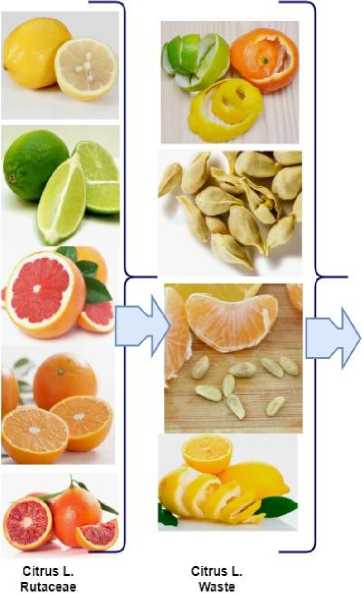

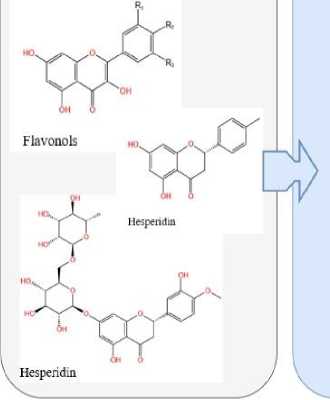
-
• Antioxidant
-
• Immunomodulatory
-
• Antihypertensive
-
• Hepatoprotective
-
• Antiallergic
-
• Cardiovascular protection
-
• Anticancer effect
-
• Antimicrobial effect

-
Fig. 1. Bioactive compounds in citrus waste and their health benefits
The primary purpose of this research was to develop optimal parameters for the extraction of biologically active compounds from the citrus peel waste (CPW) of various citrus species and to analyze the antioxidant and bioactive properties of extracts.
Materials and methods
The experimental scheme is presented in Fig. 2. Based on the results of previous scientific studies on the extraction of polyphenols from fruit waste, in this experiment bioactive substances were extracted from the CPW of sweet orange and grapefruit by the traditional maceration method using the ethanol of various concentrations as a solvent. Detailed information on sample grouping and extraction parameters is provided in Table.
To confirm the bioactive properties of the obtained extracts, the following parameters were determined: antioxidant activity, content of polyphenols and flavonoids. The antioxidant activity of orange and grapefruit peel extracts was measured by DPPH (1,1-diphenyl-2-picrylhydrazino) assay. The total phenolic content of the samples was determined according to the Folin-Chocalteu reagent method with slight modification; the total flavonoid content was determined spectro- photometrically by color reaction with 2.5 % aluminum chloride solution.
Results and Discussion
Maceration is a simple extraction method involving the immersion of the pretreatment plant material form in a suitable extraction solvent for at least three days at room temperature with intermittent stirring. It is crucial to choose the correct solvent during the maceration process, which should not destroy the BAS, but at the same time be easily separated from the extract. However, this extraction method has certain drawbacks, such as low extraction efficiency and long extraction time. However, by optimizing the type of solvent, its concentration, and the ratio of solvent to citrus peel extraction, excellent efficiency can be attained.
As shown in Fig. 3, the superoxide anion radical activity from CPW extracts with different concentrations of ethanol varied significantly. Specifically, orange peel extracts exhibited lower antioxidant activity compared to extracts from grapefruit waste. For grapefruit peel extract samples, at an ethanol concentration of 70 %, the ability to neutralize free radicals was the highest and reached 87 %. With increasing ethanol concentration, the antioxidant capacity of grapefruit peel extract gradually decreased. When the ethanol
Citrus peel waste
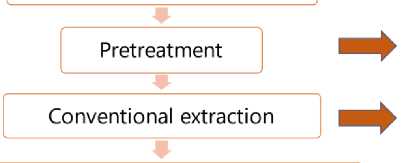
Physical treatment Washing, Drying, crushing
Separation, isolation, purification
Maceration , 20h
Determination, Experiment
Antioxidant properties, TPC, TFC, Oil anticorrosion, Paramecium
Data analysis
-
Fig. 2. The scheme of the experiment
Table
Extraction parameters of bioactive components from CPW
|
Indicators |
CS1 / CP1 |
CS2 / CP2 |
CS3 / CP3 |
CS4 // CP4 |
|
Sample/ Solvent (ethanol) ratio (v:w) |
1:10 |
|||
|
Type of citrus peel |
Orange peel (CS) / Grapefruit peel (CP) |
|||
|
Solvent concentration |
70 % |
80 % |
90 % |
100 % |
|
Maceration time (h) |
Extraction with continuous stirring for 20 hours at 40 °C |
|||
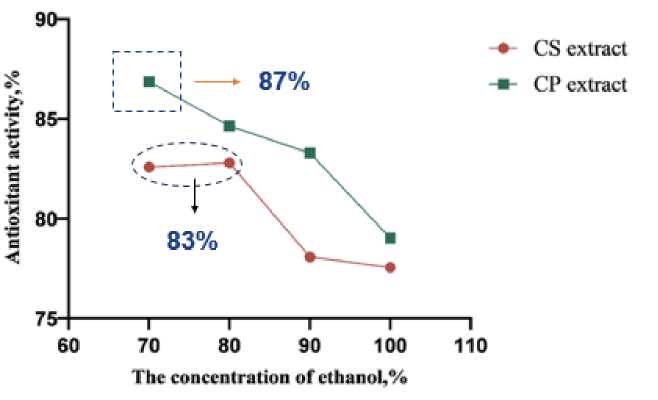
Fig. 3. Superoxide anion radical scavenging ability of citrus extracts CS –orange peel extract; CP– grapefruit peel extract
concentration was 100 %, the free radical scavenging ability of the extract was only 78 %. The antioxidant activity of orange peel extracts demonstrated a similar tendency, but the free radical scavenging ability of the extracts obtained from 70 % and 80 % ethanol concentration was quite similar around 83 %. In terms of free radical scavenging ability, the extract obtained using aqueous ethanol as solvent agent, characterized by higher antioxidant activity, while the extract obtained with 100 % ethanol exhibited the lowest antioxidant activity.
Fig. 4 indicates that at an ethanol concentration of 70 %, the yield of polyphenols from CPW was the highest, the total polyphenol content for orange peel reached 4.5494 mg GAE/g, and the highest yield of grapefruit peel polyphenols amounted to 4.4337 mg GAE/g. With increasing an ethanol concentration, the migration of polyphenols from the peel to extracts gradually de- creased, which can be associated with the fact that the polyphenolic substances of citrus peels are could be both water-soluble and soluble in organic agents.
The results of extraction of total flavonoids are demonstrated in Fig. 5. At an ethanol concentration of 90 %, orange peel showed the highest flavonoid yield of 1.7371 mg EQ/g. For grapefruit peel, at an ethanol concentration of 70 %, the maximum flavonoid yield was 1.0062 mg EQ/g.
Conclusion
Different parts of citrus fruit waste contained various phytochemicals that are beneficial to health. These compounds are extracted by using various extraction techniques, including ultrasonic extraction, microwave assisted extraction, and enzymatic extraction. In this experiment, we extracted biologically active substances from citrus peel waste using the traditional maceration method by ethanol of various concentrations. It has
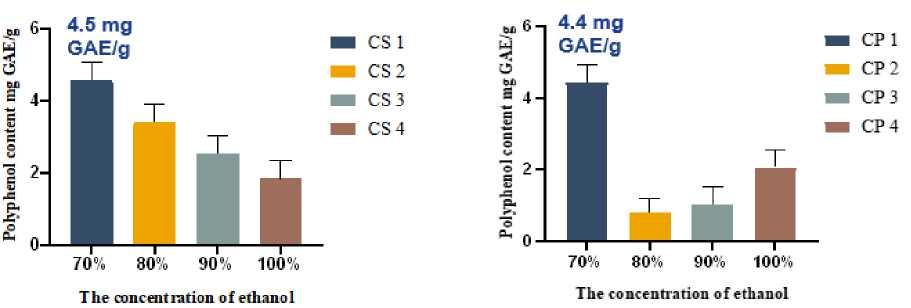
a)
b)
Fig. 4. Total polyphenols content in citrus peel extract: a – orange peel extract; b – grapefruit peel extract
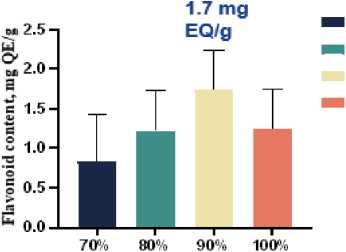
CS 1
CS2
CS3
CS-l
The concentration of ethanol
a)
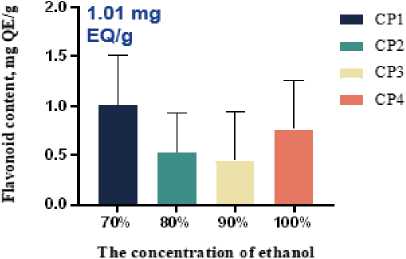
b)
Fig. 5. Total flavonoids content of citrus peel extract: a – orange peel extract; b – grapefruit peel extract
been proved that with increasing ethanol concentration, the migration of polyphenols from the peel to extracts gradually decreased. The highest antioxidant activity and the highest content of polyphenolic compounds in citrus extracts were found at an ethanol concentration of 70–80 %.

